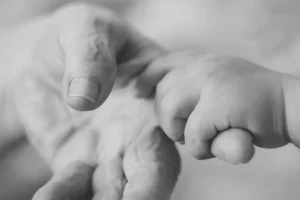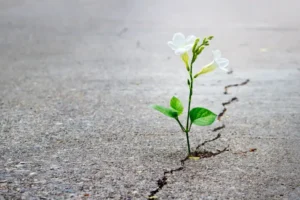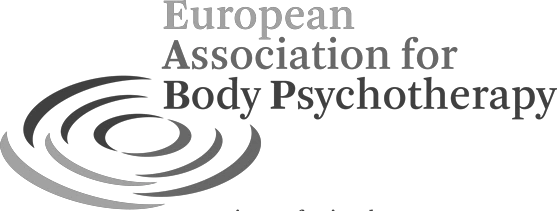Character Development with Bodynamic®
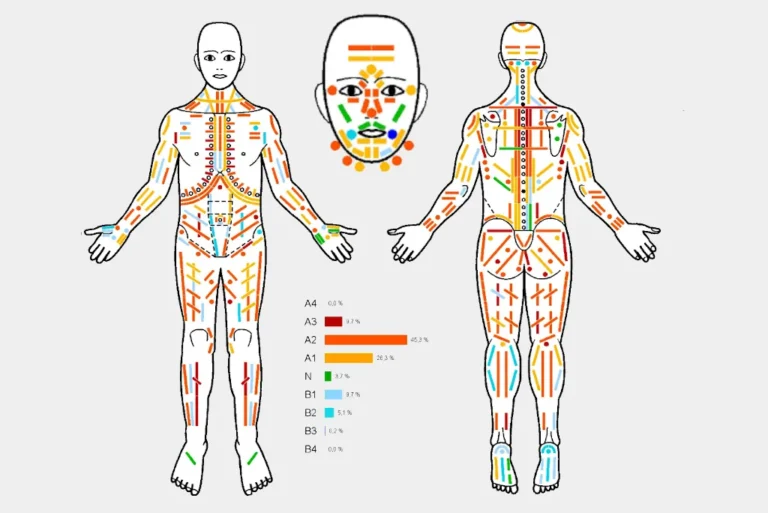
What is Bodynamic?
The Bodynamic® approach is a modern body-oriented psychotherapy that emphasizes the connection between your emotions and your body. It focuses on the developmental process of personality and uses specific body exercises to explore patterns of holding and tension in the body. By resolving these patterns, the individual can integrate emotional experiences and develop self-regulation, self-confidence and self-efficacy.
The core of the Bodynamic is to enable people to have both individual dignity as well as mutual connection in the contact with others. The balance between dignity and social belonging is moderated with the help of Ego Functions, which can be learned as skills and tools. Ego functions are action competencies that allow me to find an individual compromise when dealing with other people that maintains my dignity and at the same time allows me to have good relationships with others.
Bodynamic coaching and therapy are about bringing additional skills to life and thus creating new options for action and enabling a more fulfilling life. Bodynamic follows a pedagogic approach in building up competences.
Bodynamic has been developed by Lisbeth Marcher and her colleagues in Denmark since the 1960s. Today it is being taught and applied across Europe, Asia and the Americas.
For which topics is Bodynamic suitable?
Bodynamic has a wide range of application and can be applied to various individual challenges:
- Psychological issues (e.g. fears, psychological stress, trauma)
- Emotional issues (e.g. dealing with strong emotions such as anger, sadness, fear)
- Social issues (e.g. relationship issues)
- Professional issues (e.g. stress management, dealing with challenges, setting boundaries at work, improving in sales pitches and negotiations, etc.)
- Conflict management (finding a balance between dignity and belonging)
How does a Bodynamic session work?
Bodynamic sessions take place in a safe environment. Safe social contact creates the safety to address difficult topics. Every Bodynamic session has a very practical goal:
- The starting point is the question: “What do you want to change?”
- Change is understood as a practical change in experience and behaviour in the here-and-now.
- The past is only considered insofar as it affects the present.
As in other body psychotherapy modalities, in a Bodynamic session the subject is explored less through conversation and more as a holistic view of the body and mind. Cognitive transformation (new insights, new beliefs, new consideration of the past) often comes at the end of a chain that starts with sensations, emotions and body awareness/movement.
In a Bodynamic session, body, mind and emotion come together.
Precise pedagogic approach – precise targeting of the body
In decades of research and application, the Bodynamic team led by Lisbeth Marcher has developed a concept regarding how muscles are associated with psychological functions. Bodynamic practitioners have precise knowledge of how psychological skills can be developed by working with the muscles. In doing so they follow primarily a pedagogic approach, allowing the clients to learn and fine-tune specific psychological skills in an age appropriate way.
When working with the individual client and their concerns, they can also use the Bodynamic Bodymap, a specific diagnostic tool, to find out which muscles in a person need special attention and what kind of work is required.
Emotional fitness training involving the body
Bodynamic Coaching and Psychotherapy focuses on the psychological functions of muscles and fascia. It’s about how emotional issues in contact with other people can be supported by the muscles.
The exercises are therefore not fitness or strength training, but work with sensing and awareness to develop psychological competencies. A “psychological training” of muscles is unrelated to the physical strength or performance of the muscle. Bodynamic exercises are not designed to treat physical ailments.
By focusing on the muscular system and motoric and sensoric functions, Bodynamic approach closes the gap between, on the one hand, coaching and cognitive behavioral therapy (i.e. working with conscious cognitive processes) and, on the other hand, approaches such as Somatic Experiencing, which primarily work with the autonomic nervous system.
Bodynamic promotes the “psychological power” of the muscles.
The Bodynamic approach to personal development
The Bodymap – The Bodynamic Personality Profile
Bodynamic has a unique diagnostic tool: The Bodymap – a bodymap of muscle reactivity.
The bodymap is about understanding how the personality currently works: In relation to which topics can the person usually react flexibly and in which areas there may be a tendency towards inflexible or unconscious behavioural patterns.
The bodymap depicts the actual state in the here and now. It reflects the life story and the current demands of life.
Knowledge of the psychological functions of the muscles allows targeted development of additional competencies. At the same time, knowledge of developmental physiology (which muscle is activated in which phase of child development) makes it possible to identify and work on early trauma in a targeted manner.
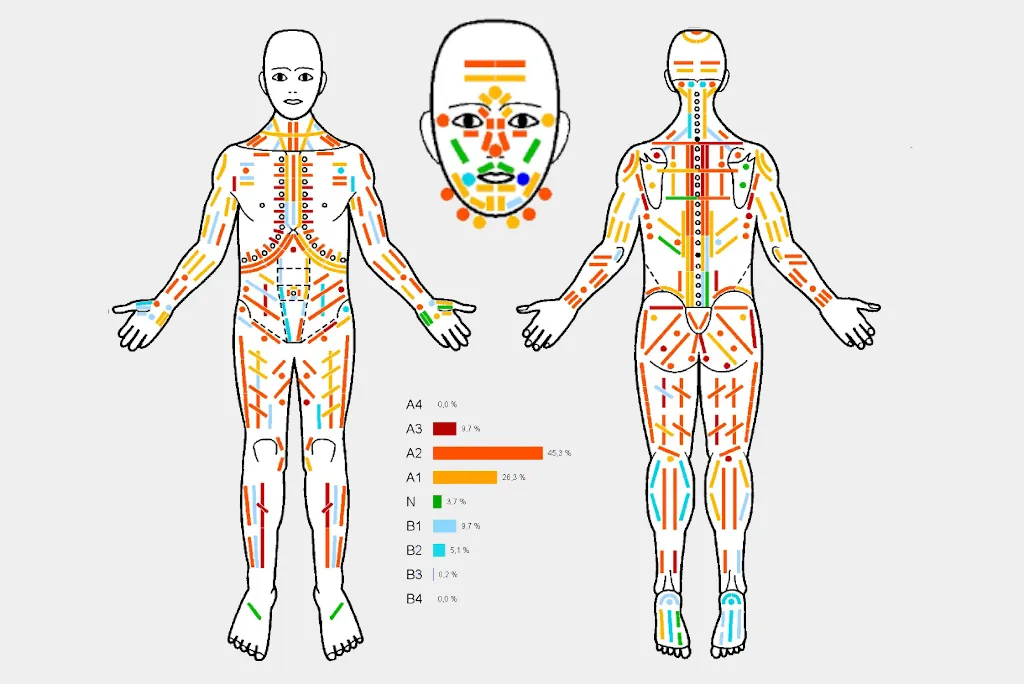
Comparison of the Bodymap with self-perception and external perception
In the conversation, the bodymap is related to the person’s own perception and perception of others. The focus is on the concrete coaching or therapy concerns:
- How does the person experience itself?
- How do others experience the person?
- Where are obstacles in contact with yourself or with other people?
The bodymap is not interpreted on its own. Rather, it is a tool to identify intervention options for the client’s concerns and to create a psychological treatment plan.
Improvement of the individual competence profile
Based on the concrete coaching or therapy concerns, additional action competence in relation to emotional experience and social contact is then built up in the work with specific muscles.
Multidimensional therapeutic approach
The Bodynamic system is particularly suitable for deep individual therapeutic or coaching work including the work to resolve developmental and relational or attachment trauma.
The Bodynamic personality model is characterized by a particularly close interlocking of somatic approaches (muscle and fascial system) and psychological perspectives. A total of 125 muscles are associated with in detail
- Developmental stages of ego consciousness (Ego Aspects)
- Practical skills and competencies (Ego Functions)
- Developmental themes of psycho-social development from early childhood to adulthood and related behavioural patterns (Character Structures)
In addition there is a detailed model of internal processing and external communication (the Bodyknot), which allows putting internal experience and external behaviour under the microscope.
In this way, there are a number of starting points that make it possible to proceed in a body-oriented manner in the here-and-now and at the same time to work specifically on the subject, on the client’s concerns.
Ego Aspects
Developmental stages of Ego Consciousness
- Body-Ego
- Individual Ego
- Role Ego
- Observing Ego
- Integrating Ego
Areas outside the conscious Ego
- Instincts
- Automatic Skills
- Higher Self
Character Structures
Developmental phases of psycho-social development from early childhood to adulthood
In each phase, 3 Positions are distinguished:
- early – resigned / withdrawn
- late – held back
- balancing – flexible
Bodyknot Steps
Steps of inner processing
Emotional Experience – Decision – Action
Emotional congruence and complete processing can be supported in a number of ways
Ego Functions
Areas of practical skills and competencies
- Connectedness
- Positioning
- Centering
- Boundaries / Personal Space
- Grounding & Reality Testing
- Energy Management
- Social Balance
- Cognitive Skills
- Self Assertion
- Interpersonal Skills
- Gender Skills



